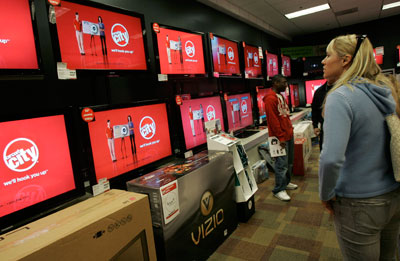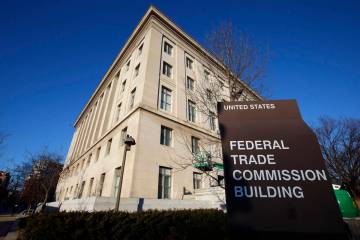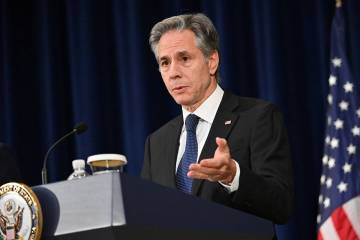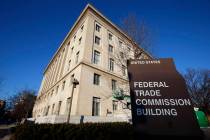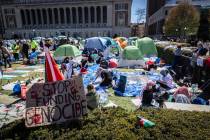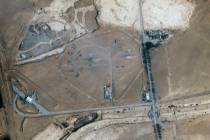Four valley locations affected by Circuit City closure
The closure of bankrupt electronics retailer Circuit City Stores will take with it four Las Vegas-area locations and add to the city’s mounting inventory of vacant retail space.
Circuit City officials said Friday they couldn’t find a buyer for the company’s assets, so they’ll liquidate all 567 of the chain’s U.S. stores. Liquidation sales were scheduled to begin this morning and continue through March.
Included in the liquidation are local stores at 3778 S. Maryland Parkway; 5055 W. Sahara Ave.; 561 N. Stephanie St.; and 7781 W. Tropical Parkway.
Circuit City, which is the nation’s second-biggest consumer electronics retailer after Best Buy, also has one store in Reno, on Kietzke Lane.
Neither local store managers nor staffers in Circuit City’s media relations department would disclose how many employees work inside each Nevada store, but company executives say the retailer has about 34,000 workers nationwide.
“This is the only possible path for our company,” James A. Marcum, acting chief executive, said in a statement. “We are extremely disappointed by this outcome.”
Local shopping-center landlords are likely disappointed as well.
Circuit City’s stores typically consume 30,000 to 50,000 square feet of big-box space, and they typically serve as anchors that lure in consumers who’ll also do business with smaller retailers inside a shopping center.
And with the Las Vegas Valley’s retail vacancy rate already approaching 10 percent — compared with less than 3 percent in mid-2006 — adding to the market what may be more than 150,000 square feet of space could force even more competition for landlords looking to reload emptied shopping centers, said Zack Hussein, a senior retail associate with local commercial real estate brokerage CB Richard Ellis.
Agreed Kit Graski, senior vice president of retail for Voit Commercial Brokerage in Las Vegas: “We just don’t need four more new big boxes showing up on the radar. It has a pretty important effect on the market.”
The biggest effect, at least initially, will be on centers that housed Circuit City. As a major tenant, Circuit City would have generated much of the parking-lot hustle and bustle that helps a center look alive to potential shoppers, Hussein said. And with the economy in recession, vacancies will probably outstrip demand for the newly empty spaces, at least for a while.
What’s worse, the smaller retailers surrounding big-box anchors often rely on foot traffic at major retailers to gin up business for their own operations. The shuttering of a key anchor could cascade through a center, resulting in additional failures among smaller shops, Graski said.
That’s a fate Terri Sturm, chief executive officer of retail developer Territory Inc., said she believes her company can avoid.
Territory’s Centennial Center in northwest Las Vegas includes a 33,000-square-foot Circuit City store among its tenants.
But Centennial Center’s situation is “unique,” Sturm said. The project has nearly 1 million square feet of space, as well as eight other major anchors, so City Center’s closing shouldn’t substantially harm the overall development. Territory has already fielded calls from big national retailers asking about the space should Circuit City fail, Sturm said.
“I think we’ll have decent luck in getting it refilled,” Sturm said, though she acknowledged that it’s a “lousy time” to be negotiating deals with major retailers.
For smaller centers, such as the Sahara Avenue strip mall that claims Circuit City as its only big anchor, or for any landlord simply struggling to compete for tenants amid rising space inventory, Circuit City’s closing will hurt. Landlords could adjust to growing vacancies in several ways.
They might chase alternate users experiencing expansion these days, such as dollar stores, other discounters, Hispanic grocers or entertainment retailers that combine food with arcades or miniature golf courses, Hussein said. Or they could subdivide big boxes into junior segments and pursue more plentiful smaller retailers.
They’ll almost certainly have to lower their rents. That’s a tack many local landlords have taken: The average retail rent in Las Vegas was $2.14 per square foot per month in the fourth quarter, down 6 cents from the third quarter, CB Richard Ellis’ numbers show. It’s a retailer’s market, with store owners managing to cut some “very aggressive” deals with desperate landlords, Graski said.
“Retailers really have all the muscle today,” Graski said. “It’s going to be the year of the retailer, and this (Circuit City liquidation) doesn’t help.”
The fallout could continue through 2009.
Circuit City had struggled for several years, as Best Buy began aggressively catering to wider demographics and eating competitors’ market share. The recession provided the death blow, and the same thing could happen to other hurting retailers.
“It was the perfect storm of the recession and the financial collapse that sealed their fate,” Hussein said. “You’ll see many retailers that are marginal performers that are going to face the same situation. Vendor credit is tight, lending is tight and financing for operating costs is tight. We’re seeing downward trends in consumer spending. Many retailers are going to have to rethink whether they can survive.”
Higher vacancies and lower rents could squeeze retail landlords and keep them from keeping up with mortgage payments. Graski’s predicting a “huge” round of landlord foreclosures in coming months.
Sturm said rising retail vacancies benefit some sides. Mid-sized retailers who’ve weighed entering the local market will find a number of good locations available across the city.
“This may be a good opportunity for regional players to spread out and gain market share,” she said.
Circuit City had been seeking a buyer or a deal to refinance its debt, but the hobbled credit market and consumer worries proved insurmountable.
The liquidation of Circuit City is the latest fallout from the worst holiday shopping season in four decades. People have slashed their spending since the financial meltdown in September as they worry about their job security and declining retirement funds.
Circuit City said in court papers it has appointed Great American Group LLC, Hudson Capital Partners LLC, SB Capital Group LLC and Tiger Capital Group LLC as liquidators.
“Regrettably for the more than 30,000 employees of Circuit City and our loyal customers, we were unable to reach an agreement with our creditors and lenders,” Marcum said.
Shareholders are likely to receive nothing, as is typical in bankruptcy cases. It was unclear what would happen to the company’s 765 retail stores and dealer outlets in Canada.
Circuit City filed for Chapter 11 bankruptcy protection in November as vendors started to restrict the flow of merchandise ahead of the busy holiday shopping season.
It had been exploring strategic alternatives since May, when it opened its books to Blockbuster Inc. The Dallas-based movie-rental chain made a takeover bid of more than $1 billion with plans to create a 9,300-store chain to sell electronic gadgets and rent movies and games. Blockbuster withdrew the bid in July because of market conditions.
Circuit City, which said it had $3.4 billion in assets and $2.32 billion in liabilities as of Aug. 31, said in its initial filings that it planned to emerge from court protection in the first half of this year.
U.S. Bankruptcy Judge Kevin Huennekens had given the company permission to liquidate if a buyout was not achieved. The company still needs final approval of a liquidation from the court.
Contact reporter Jennifer Robison at jrobison@reviewjournal.com or 702-380-4512. The Associated Press contributed to this report.



